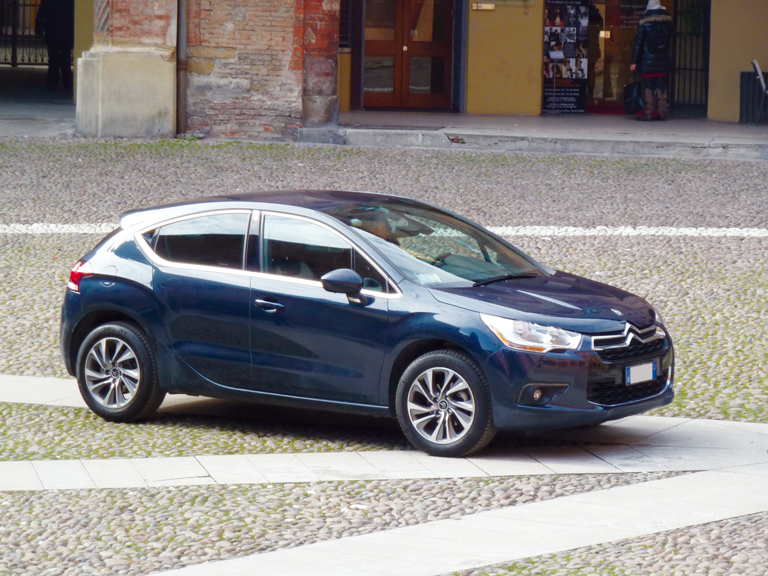|

From goddess to
different spirit.
After more than 50 years the meaning changes but not the
substance. If the shark designed by Flaminio Bertoni
in 1955 revolutionized the concept of the automobile,
earning it the divine nickname derived from the French
pronunciation of the DS code:
déesse, the new DS model announces its
different spirit with its bold lines.
It is a bold style, obvious in the intermediate model of the
series, the DS4, which we tested in the version 1.6 VTi So
Chic with EvoPower LPG fuel system. A crossover that
tastefully mixes the lines of the SUV with the design of a
coupé, with details like the handles on the rear doors
concealed in the window frames and the dip of the tail: a
compact that measures 4.28 meters, is 1.81 meters wide and
1.53 high, Voted the best looking car in 2011 and Auto of
Europe for 2012. The tradeoff for the fine esthetics is the
loss of some practicality, as in the case of the reduced
rear visibility and the rather awkward backseat access,
where this is not much room for the legs and the windows are
fixed. It’s roomy enough in front, however, with higher than
average seats that even offer lumbar massage, as well as a
panoramic windshield that provides good light and
visibility. Like the outside, the interior design is
prestigious, at the same level as the finishing and
materials used. Good ergonomics, thanks to the rational
arrangement of the commands and the multifunction steering
wheel that can also be used to operate the main elements.
The dashboard is not as praiseworthy: though the design is
lovely, the legibility could use improvement, despite the
possibility of choosing the intensity and color of the
lighting. The LPG switch/level gauge is not sufficiently
visible while driving, but is well integrated in the
instrument panel, to the left of the steering wheel.
The gas tank holds 44 liters
(35.2 effective for autonomy of about 350 km) and is located
in the spare tire compartment, replaced with a rapid tire
repair kit. The location leaves the baggage space unchanged
at 385 liters (1,021 with the back seats down) and the
versatility of the luggage compartment, which is regular and
nicely finished, but with a high threshold of loading bay
that does not facilitate loading and unloading operations.
The EvoPower kit is complete with the parts under the hood:
the RunOil is outstanding, and makes all the systems except
the valves electronic, here in combination with the JLM, a
device developed by RunTek that should guarantee adequate
lubrication of the combustion chamber, to safeguard the
valves and their housings. The system is programmed to
distribute the proper amount of additive on the basis of the
number of rpm and injection timing, i.e. as effectively
needed by the engine.
The kilometers of our test, driven in and around Bologna,
were sufficient to observe the efficiency of the kit
developed by PowerJet Lpi
in collaboration with Emmegas.
The system maintains the performance of the DS4 unchanged
and does not have any effect on the high elasticity of drive
of the 4 cylinder Valvetronic with 120 cv and 160 Nm at 4,250 rpm.
The gradual delivery of power ensures fluid pickup starting
from 1,000 rpm and driving is relaxed, without the need for
too much shifting of the five-speed gears. But those who
prefer to use a more active driving style will enjoy the
sparkling performance that exalts the dynamism of the DS4.
Which is considerable, though the rigid shock decrease the
comfort and make the reactions a bit nervous
in critical situations, such as when driving on a slippery
surface. The electronic traction devices and stability of
the braking system, with self-ventilating front disks,
ensure active safety. The steering is good – accurate and
direct – as is the maneuverability of the gearshift.
The most interesting aspects of the DS4 EvoPower concern
emissions and operating costs. CO2 emissions are about 15%
lower, from 144 to 122 grams/km, while for pollutants the
reductions greatest reductions are in carbon monoxide and
fine particulate. Savings on fuel costs are close to 50%,
going from 0.157 €/km with gasoline to 0.084 with LPG. These
values are calculated considering for gasoline an average
consumption of 8.7 l/100 km (official data says 6.2) and a
price at the pump of 1.8 €/liter and for gas of 10 l/100 km
at 0.84 euro/liter, plus 0.17 cents/km for the additive the
full tank of 0.5 liters costs about 10 euro and should be
sufficient for an average of 6,000 km).
The difference of 0.0709 €/km
means that the cost of the gas system (about 1,600 euro,
with a 2-year warranty) is recovered in just 22,500 km. The
kilometer cost with GPL is a little higher (0.0857 euro/km
compared with 0.080 for the diesel) with respect to the
thriftier diesel model, the 1.6 e-HDi with 114 cv, even
though we consider the approved data (4.7 l/100 km) to be
unreliable. One version is listed at 25,450 euro, 700 more
than the 24,750 euro necessary to buy the DS4 1.6 VTi with
the EvoPower and So Chic design that, among other things,
includes sex airbags, cruise
control, dual zone air conditioning, rearview mirrors with
blind spot monitoring and fog lights with cornering
function, as well as the system of automatic rescue call in
case of accident.
(Ecomobile NR.105 Jan-Feb 2013)
Stefano Panzeri
I read and..:
|
